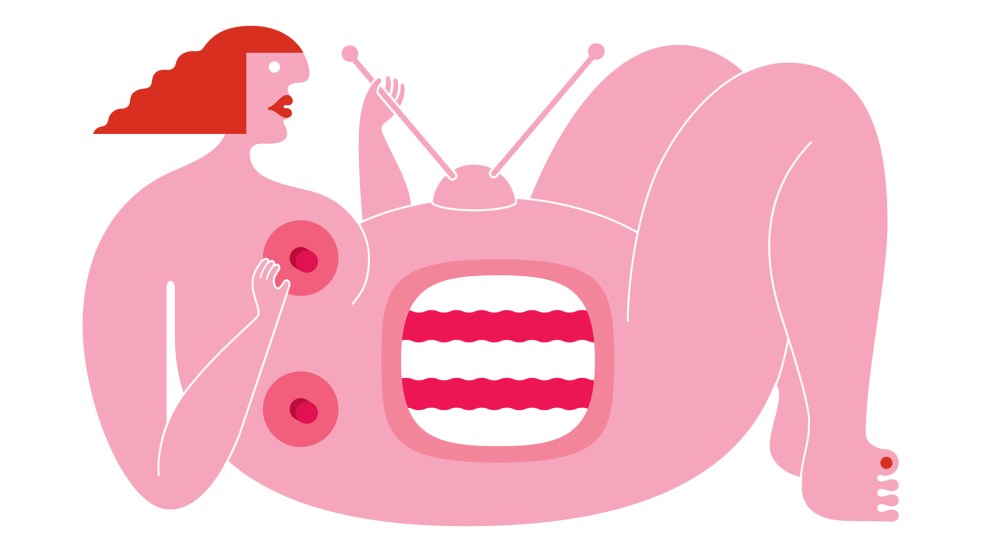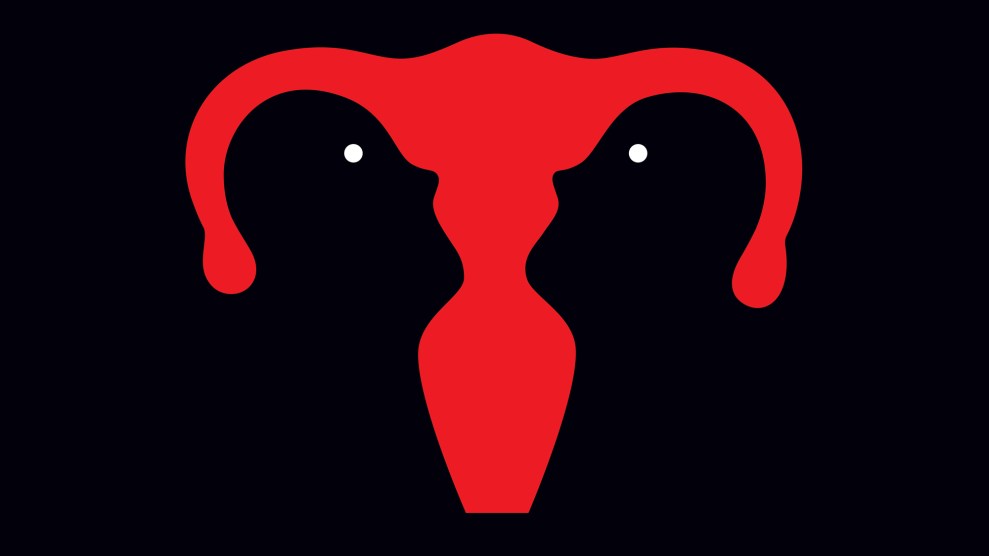
Melinda Beck
In 1981, eight years after Roe v. Wade legalized abortion and just a year before her breakout role as pregnant Stacy in Fast Times at Ridgemont High, Jennifer Jason Leigh played another apparently knocked-up high schooler, this time in a CBS after-school special called I Think I’m Having a Baby. Leigh is Laurie, a hard-crushing freshman taken for a roll in the leaves by the dreamy senior asshole Peter, who is cheating on his girlfriend, Phoebe, played by a hair-flipping Helen Hunt. Not to spoil it for you, but I’ll spoil it for you: Laurie is not actually having a baby. But the 29-minute near tragedy, aimed at preteens, traces her romantic and existential anguish after she tells Peter about the “pregnancy,” and Peter essentially tells her to deal with it all on her own. It’s a classic “used and discarded” story—a model of the early abortion-centric television genre.
For starters, Laurie becomes sick the day after Peter seduces her following a cookout, as if the mere proximity of sperm and egg conjures up all-day ralphing sessions. Later, she sneaks off to a local abortion clinic, where a kindly nurse offers her a pregnancy test and explains an array of options, including abortion. Only then does the 15-year-old learn that, phew, there’s nothing to worry about. The lesson here, I’m assuming, is that contraception could have saved Laurie the bellyache, except nobody specifically mentions condoms or the Pill. Instead, it’s just a ho-hum story of a close call, coupled with some truly traumatizing hair.
Today, almost 40 years later, we’re in something of a golden age of abortion TV. Such near misses are passé. So is the general air of hysteria and moral cataclysm. Now the tone is a welcome, if strained, insouciance. Characters are more likely to shrug off their abortions than agonize over them. Progress, right? Sure—except that, in the era of so-called “heartbeat” bills and the kneecapping of Planned Parenthood, a different sort of unreality has crept in. In the TV universe, it’s easy to get an abortion. In real life, vast swaths of America are essentially abortion deserts.
Television’s first significant primetime abortion actually took place two months before the Roe decision was announced, when Bea Arthur’s titular character in CBS’s Maude, a 47-year-old married grandmother, ended an unwanted pregnancy in a two-part episode titled “Maude’s Dilemma.” The show was set in New York, where abortion was already legal, but controversy reigned anyway. The network, which estimated that 65 million people watched at least one of the episodes, received some 7,000 letters of complaint.
In Maude’s aftermath it was difficult, if not impossible, to find compelling TV narratives in which women entered the clinic, put their feet in the stirrups, and ended the pregnancy. To relieve plotlines of the burden of a potential abortion, characters would discover that, like Laurie, they weren’t actually pregnant (A Different World’s Kim in 1989; 30 Rock’s Liz Lemon in the brilliantly titled “Cooter” in 2008), or they would miscarry unwanted pregnancies (All in the Family’s Gloria Stivic in 1971; Party of Five’s Julia Salinger in 1996; Beverly Hills, 90210’s Kelly Taylor in 1997). Another, even stranger cop-out would come in the form of characters like poor Cindy—a suddenly pregnant friend of Mallory Keaton on Family Ties—who appears in a 1982 episode, only to disappear from the show without any resolution. Does she have the baby? Abort it? Sell it to the circus? We have no damn idea. Cindy was just a convenient way to drum up some gasps from the audience without risking any flak from the network execs
More typically, pregnant TV characters would ponder their choices in slow-churning, emotional tsunamis of agony, before ultimately deciding to keep their unborn children. These multi-episode feats of hairpulling kept the narrative tension high but the scandal potential low. In 1985, on The Facts of Life, spoiled deb Blair convinces her own mother to keep an unwanted pregnancy through sheer, whiny willpower. Before Kelly’s pregnancy scare on 90210, buttoned-up college freshman Andrea intends to terminate her pregnancy, visits a clinic, and then keeps the baby essentially because her boyfriend threatens to break up with her if she follows through—and yet the couple ends the double episode gleefully telling friends they’re headed for the altar. Gilmore Girls’ Lane loathes her first sexual encounter, isn’t sure she’s even that into her husband, and desperately wants to be on the road with her band, but in the end she carries their twins to term. At the original series’ conclusion in 2007, the husband leaves for two months of gigs and Lane stays home. Even the actress who played Lane didn’t quite understand why the show’s writers would push her into such an unlikely ending: “In my mind,” Keiko Agena told HuffPost, “I think that Lane wouldn’t have been able to stop that creative push.”
Which isn’t to say that all TV pregnancies should end in abortion—most real-life unintended pregnancies don’t. Nor is it to suggest that every disquieted struggle to come to a decision about keeping a pregnancy—kind of a big, life-changing deal—is narratively foolish and manipulative. But this is where abortion TV stalled out, more or less for decades—in a right-wing fantasy of a woman’s internal struggle to do A Bad Thing.
It’s not hard to understand why TV execs were so gun-shy. Women on TV were damned if they aborted and damned if they didn’t. Murphy Brown’s 1991 third-season finale—the hand-tossingly titled “Uh-Oh”—ended with a positive pregnancy test for the fortysomething single news anchor. Fans had to wait until the fourth season, and a special hourlong episode, to watch Murphy vacillate between raising a child on her own and terminating the pregnancy, though the A-word is never mentioned. Only her colleague Corky, who’s as perky as a set of new boobs, offers to help her “take care of things.” She proposes a drive to a “back alley,” leading to a punchline that hardly even scans as a joke today:
Murphy: Corky, there is no back alley. Women in this country legally have a choice. At least I think they still do. I haven’t checked the paper today.
Corky: I’m sorry. I’m from Louisiana.
Ultimately Murphy chooses to keep the baby, despite her single status and her male colleagues’ doubts. Her decision so rankled Vice President Dan Quayle that he spoke out on the campaign trail, saying Murphy was “mocking the importance of fathers by bearing a child alone, and calling it just another ‘lifestyle choice.’” Within hours he walked it back, but the sting of the veep calling out your show as immoral must have stuck. It wasn’t until the mid-aughts that abortion plotlines finally stopped sounding like Tudor morality plays.
As television has entered its streaming and bingeing era, there’s been, if you’ll pardon the expression, an abortion explosion. In 2013, the research group Advancing New Standards in Reproductive Health counted 15 abortion plotlines on network and cable TV. In 2014, there were 18. In 2015, as US abortion rates dropped to their lowest in decades, there were 26. Abortion worked its way into comedy (see: Selina Meyer’s notorious line in Veep, “If men got pregnant, you could get an abortion at an ATM”). No teeth were gnashed when Girls’ Mimi-Rose chipperly told her boyfriend, “Nah, I can’t go for a run because I had an abortion yesterday,” and no garments were rent when a narrator slipped in to tell the audience that Jane the Virgin’s Xiomara had a medication abortion between episodes.
It was right around then that Shonda Rhimes crafted a nearly perfect episode of Scandal in which Olivia Pope (Kerry Washington) undergoes a wordless abortion onscreen, set to—of all things—a hymn that celebrates the birth of Jesus, “Silent Night.” This was the first time a black protagonist had the procedure onscreen, and only the second time it’s been shown at all (the first was an earlier episode of Scandal). The message was clear: Abortion isn’t always harrowing; it doesn’t necessarily foment inner turmoil; and black women, who in 2015 had 36 percent of all abortions, should be a larger part of the conversation about unintended pregnancies. It emerged later that ABC had wanted to cut the scene. In an interview with the Hollywood Reporter, Rhimes recalled telling the network, “Go ahead, alter the scene. We’ll just have a lot of articles about how you altered the scene.” Critics called the episode groundbreaking, and just three years later, in 2018, at least four female TV characters of color had abortions or disclosed past abortions.
The state of abortion on TV is getting better! critics cried—and they weren’t wrong, but they were also far from right.
There’s a wide abortion desert in this country, stretching down from North Dakota to Texas: Not a single provider operates along the 100th meridian. That’s Friday Night Lights land, and yes, a 2010 episode of the show featured a pregnant teenage girl with a supportive mother and a relatively angst-free abortion. FNL wisely included the doctor’s state-mandated script and the 24-hour waiting period that any Texan woman must endure. It was good, progressive television.
In the years since then, clinics have been wiped off the map, and ever-tighter restrictions like Georgia’s cruel new “heartbeat” bill have sailed through Republican legislatures. As of 2014, 87 percent of counties had zero clinics that offer abortions. Nobody in the entire state of Wyoming provides abortions after 12 weeks of pregnancy. If you live in West Texas or central Nevada, you might drive five hours before encountering a provider.
Yet the real-life problems with American abortion are seldom found on television. Even on prestige TV, with all its money and daring, women don’t have any trouble getting to a provider or terminating a pregnancy beyond the first trimester. Maybe this wasn’t an issue back when more than a million women a year were accessing providers in all 50 states. But TV writers today act as if every neighborhood has its own clinic attached to the post office. Where’s the scene of a woman battling with her insurance company? The close-up shot of a determined abortion seeker being shown an ultrasound of her tadpole-like fetus just so she can get on with it?
Part of this problem is geographic—there are far fewer shows about women set in the suburbs of Kansas City or the ranchlands outside Billings than there are in urban LA, or, of course, Brooklyn. Part of it, I suspect, is that men still sit atop the heap at most networks and platforms—men who hear about abortion secondhand, men who couldn’t tell you what it feels like to slide your body all the way down the examination table or how long it takes a woman on the Cheyenne River Reservation in South Dakota to get to the nearest clinic. Abortion on TV may not reflect the reality of the procedure, but it can tell us a lot about how a certain class of men understand it.
Alas, Friday Night Lights is no more, but imagine another show set in a town like Dillon, Texas, where another woman is unexpectedly pregnant. Now imagine the power of showing her hauling herself across six county lines, listening to the fetal heartbeat, watching the fetus flash in black and white on the ultrasound monitor, rifling through the forms the clinic gives her that are loaded with misleading information, struggling to come up with the $1,500 for a surgical procedure, hauling herself back home, battling with her boss for the day off, begging a friend to take her toddler for the night, sitting in her bedroom—peeved yet determined—for the 24 hours before she can drive those dry, dusty miles back to the clinic and exercise her constitutional right, weighed down with load upon load of undue burden.














